
Monday 10 February
Opportunity Knocks…….. With Katoon’s newly acquired Toyota Vios parked outside the residence there is no urgency to do anything but opportunism is all too evident now. This morning is washing day so I guess opportunity is restricted. While we have discussed plans for today, at 11am nothing is decided as I tune into the live broadcast of The Atlas 5 as it sends the Solar Orbiter aloft for its journey to the sun. I guess we won’t be travelling today but I see the opportunity to go into downtown Bangkok. However, Katoon who has been goading me for the last hour seems to have had a trip in mind. Now surely so close to lunch that just ain’t gonna happen is it?
Angthong Province…….. While I made a decision some years ago to visit all of Thailand’s provinces, or at least try to, the way we were set up made some provinces hard to plan for oddly because they were too close to Bangkok. Put simply, visits were uneconomical using a hire vehicle unless they were incorporated into longer trips. So, this is my excuse for not visiting Angthong Province before rather than declare that the province was small and insignificant; somewhere you just passed through on the way to somewhere else.
With Katoon still up for a trip to day, I start to consider what could be achieved in only half a day as I collect my thoughts as well as a few belongings. It’s now 11.30pm. Two hours later we’re taking lunch beside the mighty Chao Phraya River near Angthong. Admitting this province should be easy to cover, it still should take a full day and all the usual representations of attractions are here, natural, cultural, religious and historic. The natural incudes the Chao Phraya River itself which runs north/south through the province but its greatest attraction is historic. After and excellent meal of river fish we can make a start. If we could manage 3 or 4 attractions today that would be great.
Wat Khun Inthapamun…….. (Onsite information) At 2.30pm we arrive at Wat Khun Inthapamun. This temple ruin is located in the middle of a rice field at tambon Inthapamun, amphoe Pho Thong. It houses a massive ancient stucco reclining Buddha image 50 metres long. The Phra Wihan was a structure that protected the image but the roof collapsed long ago leaving the image in the open. In front of the image is the statue of a man. Let me introduce him. He was known as Khun Inthapamun and was a government official for the district back in the Ayutthaya Period. He held a government monopoly and was found guilty of embezzlement from the public purse for the enlargement of the Buddha image, a crime for which he was whipped to death.
It is clear that in some circles his crime was overlooked and the image renamed in his honour. However, the crime is not forgotten as his remains are on display with his legs tied and lying face down.
As is usual at many historic sites, new temple buildings have appeared for those wishing to make merit and perhaps reflect on the life and times of Khun Inthapamun. Covered in stucco.
An octagonal chedi lies next to the ubosot on the same base. The chedi is bell-shaped with tiers with only part of it surviving.
The temple was registered by the Fine Art Department in March 1935. In 1975 the reclining Buddha image was restored with further restoration by the Fine Arts Department taking place in 2012/13.
Wat Khun Intrapramun also contains an ubosot built on a base and facing east. It was built of bricks and mortar in typically Ayutthaya style. The foundation is lotus shaped and there are two entrances facing east and west while the roof has collapsed. Inside is a sandstone Buddha image covered with stucco. The octagonal chedi lies next to the ubosot on the same base. The chedi is bell-shaped with tiers but only parts of it survive.
The temple was registered by the Fine Arts Department in March 1935. In 1975 the reclining Buddha image was restored while further restoration by the Fine Arts Department took place in 2012/13.
With Wat Khun Inthapramun consuming over an hour we head south and reach Kham Yat Palace Hall.
Kham Yat Palace Hall……..source. Kham Yat Palace Hall hardly registers as an attraction using online sources but the hall is a historic palace located in the area of an abandoned temple. This palace hall used to be the abode of King Uthumphon recorded in the year 1759 who was the 33nd and penultimate monarch of the Ayutthaya Kingdom, while he was ordained as a monk and where he stayed for a period of time before returning to stay at Wat Pradu Songtham. In 1906, King Rama V came to acknowledge the hall as a royal heritage site.
It was registered as an ancient monument in Thailand by the Fine Arts Department, and is considered another tourist attraction in Angthong.
Wat Muang (Purple Temple)…….. (Onsite information) Now after 4pm we head for another important temple, this time a modern working temple which means little in the way of history to record but will nevertheless absorb time since is has been built by Buddhist pilgrims to attract Buddhist like Katoon.
The onsite information records that a temple was constructed here in the late Ayutthaya Period thought to be around 1687. The temple is situated in the historically famous city of Viset-Chaicharn. Unfortunately, it was destroyed by the Burmese army after the 2nd fall of Ayutthaya.
The temple was reconstructed by Phra Kru Viboon Ajararnrakun in 1983. On August 6, 1984 the Ministry of Education raised the status of Wat Muang to be a temple which allowed monks to stay. In October 1984, Phra Kru Viboon Ajararnrakun was appointed to be the abbot of the temple. On September 12, 1986, King Bhumibol Adulyadej royally conferred the name Visungkamasena.
In 1991, Phra Kru Viboon Ajararnrakun together with Buddhists throughout Thailand set out to build the largest Buddha Statue in the world dedicated to King Bhumibol Adulyadej. The statue took 16 years to build and was completed in 2007.
Also, to be found at Wat Muang is an ornate silver viharn decorated internally with mirrors and glass in the style of Wat Chantaram (Wat Tha Sung) in Uthai Thani. A modern park with the familiar grotesque images depicting Buddhist Heaven and Hell can also be found nearby.
Now past 5pm it is hard to see much more can be achieved. Without a plan to work with, hoping between site on a ad hoc basis does not lend itself to the most efficient use of time yet my instinct tells me to head towards the city of Angthong where I hope to locate one more attraction. Fortunately, we waist little time as we reach the outskirts of the city.
Wat Sang Kratai……..source. Wat Sang Kratai is located in Angthong City about two km west of the city centre. It’s an old temple, built more than 400 years ago, constructed in the Ayutthaya period. It was abandoned probably after the 2nd fall of Ayutthaya to the Burmese in 1767.
When worshippers returned to this temple, they found only ruins. The ruins of the ubosot (ordination hall) however are buttressed by four Pho trees at the corners and along the walls holding up the crumbling building. The ubosot was roofless but shaded by the leafy boughs of the Pho trees.
The ubosot is divided into three rooms each with a huge Buddha statue inside. The temple used to be called Wat Sam Kratai or the three Rabbits Temple (sam – three, kratai – rabbit). Over time the name was changed to the present, Wat Sang Kratai.
The ruin has been registered as an ancient site by the Bepartment of Fine arts.
Wat Pa Mok Worawihan…….. The last attraction has consumed little time and Katoon mentions another temple she spotted on the way here. It’s a long shot but as we are heading south following the Chao Phraya River anyway there’s nothing to lose and by 6pm we locate yet another ancient temple and there still about 15 minutes of daylight left. However, there’s a catch. The most important exhibit at Wat Pa Mok Worawihan is in the viharn and that’s now locked. The keyholder has just left.
Wat Pa Mok Worawihan is a temple is located in Amphoe Pa Mok on the west bank of the Chao Phraya River, 18 kilometres south of the Ang Thong. There is an old reclining Buddha image assumed to have been constructed during the Sukhothai period. The image is 22.58 metres long, made of brick and mortar, and covered with gold. It is found in the royal records that King Naresuan also visited this temple to pay homage to this reclining Buddha image prior to leading the army to fight King Maha Uparacha of Burma.
While we have missed out by a whisker, we spend the remaining daylight to wander through the buildings and are shown the hall where King Naresuan was supposed to have stayed. There is enough evidence still here to suggest is was in use throughout the Ayutthaya period and probably sometime beyond.
And Finally…….. It is time to leave just as darkness falls but not before in the dim light, we locate Nai Dok Nai Thongkaeo Monument on the main road in front of the temple complex now brightly lit. The circumstances have not allowed me to investigate but the memorial points to the struggle against the Burmese invaders by local commanders. The journey back to Bangkok more or less the way we came allows us to return to base around 8.30pm and needs no further comment. However, opportunism has allowed me to pull a big fat rabbit out of the hat today as one more province succumbs to my eagle eye.
Opportunity Knocks…….. With Katoon’s newly acquired Toyota Vios parked outside the residence there is no urgency to do anything but opportunism is all too evident now. This morning is washing day so I guess opportunity is restricted. While we have discussed plans for today, at 11am nothing is decided as I tune into the live broadcast of The Atlas 5 as it sends the Solar Orbiter aloft for its journey to the sun. I guess we won’t be travelling today but I see the opportunity to go into downtown Bangkok. However, Katoon who has been goading me for the last hour seems to have had a trip in mind. Now surely so close to lunch that just ain’t gonna happen is it?
Angthong Province…….. While I made a decision some years ago to visit all of Thailand’s provinces, or at least try to, the way we were set up made some provinces hard to plan for oddly because they were too close to Bangkok. Put simply, visits were uneconomical using a hire vehicle unless they were incorporated into longer trips. So, this is my excuse for not visiting Angthong Province before rather than declare that the province was small and insignificant; somewhere you just passed through on the way to somewhere else.
With Katoon still up for a trip to day, I start to consider what could be achieved in only half a day as I collect my thoughts as well as a few belongings. It’s now 11.30pm. Two hours later we’re taking lunch beside the mighty Chao Phraya River near Angthong. Admitting this province should be easy to cover, it still should take a full day and all the usual representations of attractions are here, natural, cultural, religious and historic. The natural incudes the Chao Phraya River itself which runs north/south through the province but its greatest attraction is historic. After and excellent meal of river fish we can make a start. If we could manage 3 or 4 attractions today that would be great.
Wat Khun Inthapamun…….. (Onsite information) At 2.30pm we arrive at Wat Khun Inthapamun. This temple ruin is located in the middle of a rice field at tambon Inthapamun, amphoe Pho Thong. It houses a massive ancient stucco reclining Buddha image 50 metres long. The Phra Wihan was a structure that protected the image but the roof collapsed long ago leaving the image in the open. In front of the image is the statue of a man. Let me introduce him. He was known as Khun Inthapamun and was a government official for the district back in the Ayutthaya Period. He held a government monopoly and was found guilty of embezzlement from the public purse for the enlargement of the Buddha image, a crime for which he was whipped to death.
It is clear that in some circles his crime was overlooked and the image renamed in his honour. However, the crime is not forgotten as his remains are on display with his legs tied and lying face down.
As is usual at many historic sites, new temple buildings have appeared for those wishing to make merit and perhaps reflect on the life and times of Khun Inthapamun. Covered in stucco.
An octagonal chedi lies next to the ubosot on the same base. The chedi is bell-shaped with tiers with only part of it surviving.
The temple was registered by the Fine Art Department in March 1935. In 1975 the reclining Buddha image was restored with further restoration by the Fine Arts Department taking place in 2012/13.
Wat Khun Intrapramun also contains an ubosot built on a base and facing east. It was built of bricks and mortar in typically Ayutthaya style. The foundation is lotus shaped and there are two entrances facing east and west while the roof has collapsed. Inside is a sandstone Buddha image covered with stucco. The octagonal chedi lies next to the ubosot on the same base. The chedi is bell-shaped with tiers but only parts of it survive.
The temple was registered by the Fine Arts Department in March 1935. In 1975 the reclining Buddha image was restored while further restoration by the Fine Arts Department took place in 2012/13.
With Wat Khun Inthapramun consuming over an hour we head south and reach Kham Yat Palace Hall.
Kham Yat Palace Hall……..source. Kham Yat Palace Hall hardly registers as an attraction using online sources but the hall is a historic palace located in the area of an abandoned temple. This palace hall used to be the abode of King Uthumphon recorded in the year 1759 who was the 33nd and penultimate monarch of the Ayutthaya Kingdom, while he was ordained as a monk and where he stayed for a period of time before returning to stay at Wat Pradu Songtham. In 1906, King Rama V came to acknowledge the hall as a royal heritage site.
It was registered as an ancient monument in Thailand by the Fine Arts Department, and is considered another tourist attraction in Angthong.
Wat Muang (Purple Temple)…….. (Onsite information) Now after 4pm we head for another important temple, this time a modern working temple which means little in the way of history to record but will nevertheless absorb time since is has been built by Buddhist pilgrims to attract Buddhist like Katoon.
The onsite information records that a temple was constructed here in the late Ayutthaya Period thought to be around 1687. The temple is situated in the historically famous city of Viset-Chaicharn. Unfortunately, it was destroyed by the Burmese army after the 2nd fall of Ayutthaya.
The temple was reconstructed by Phra Kru Viboon Ajararnrakun in 1983. On August 6, 1984 the Ministry of Education raised the status of Wat Muang to be a temple which allowed monks to stay. In October 1984, Phra Kru Viboon Ajararnrakun was appointed to be the abbot of the temple. On September 12, 1986, King Bhumibol Adulyadej royally conferred the name Visungkamasena.
In 1991, Phra Kru Viboon Ajararnrakun together with Buddhists throughout Thailand set out to build the largest Buddha Statue in the world dedicated to King Bhumibol Adulyadej. The statue took 16 years to build and was completed in 2007.
Also, to be found at Wat Muang is an ornate silver viharn decorated internally with mirrors and glass in the style of Wat Chantaram (Wat Tha Sung) in Uthai Thani. A modern park with the familiar grotesque images depicting Buddhist Heaven and Hell can also be found nearby.
Now past 5pm it is hard to see much more can be achieved. Without a plan to work with, hoping between site on a ad hoc basis does not lend itself to the most efficient use of time yet my instinct tells me to head towards the city of Angthong where I hope to locate one more attraction. Fortunately, we waist little time as we reach the outskirts of the city.
Wat Sang Kratai……..source. Wat Sang Kratai is located in Angthong City about two km west of the city centre. It’s an old temple, built more than 400 years ago, constructed in the Ayutthaya period. It was abandoned probably after the 2nd fall of Ayutthaya to the Burmese in 1767.
When worshippers returned to this temple, they found only ruins. The ruins of the ubosot (ordination hall) however are buttressed by four Pho trees at the corners and along the walls holding up the crumbling building. The ubosot was roofless but shaded by the leafy boughs of the Pho trees.
The ubosot is divided into three rooms each with a huge Buddha statue inside. The temple used to be called Wat Sam Kratai or the three Rabbits Temple (sam – three, kratai – rabbit). Over time the name was changed to the present, Wat Sang Kratai.
The ruin has been registered as an ancient site by the Bepartment of Fine arts.
Wat Pa Mok Worawihan…….. The last attraction has consumed little time and Katoon mentions another temple she spotted on the way here. It’s a long shot but as we are heading south following the Chao Phraya River anyway there’s nothing to lose and by 6pm we locate yet another ancient temple and there still about 15 minutes of daylight left. However, there’s a catch. The most important exhibit at Wat Pa Mok Worawihan is in the viharn and that’s now locked. The keyholder has just left.
Wat Pa Mok Worawihan is a temple is located in Amphoe Pa Mok on the west bank of the Chao Phraya River, 18 kilometres south of the Ang Thong. There is an old reclining Buddha image assumed to have been constructed during the Sukhothai period. The image is 22.58 metres long, made of brick and mortar, and covered with gold. It is found in the royal records that King Naresuan also visited this temple to pay homage to this reclining Buddha image prior to leading the army to fight King Maha Uparacha of Burma.
While we have missed out by a whisker, we spend the remaining daylight to wander through the buildings and are shown the hall where King Naresuan was supposed to have stayed. There is enough evidence still here to suggest is was in use throughout the Ayutthaya period and probably sometime beyond.
And Finally…….. It is time to leave just as darkness falls but not before in the dim light, we locate Nai Dok Nai Thongkaeo Monument on the main road in front of the temple complex now brightly lit. The circumstances have not allowed me to investigate but the memorial points to the struggle against the Burmese invaders by local commanders. The journey back to Bangkok more or less the way we came allows us to return to base around 8.30pm and needs no further comment. However, opportunism has allowed me to pull a big fat rabbit out of the hat today as one more province succumbs to my eagle eye.
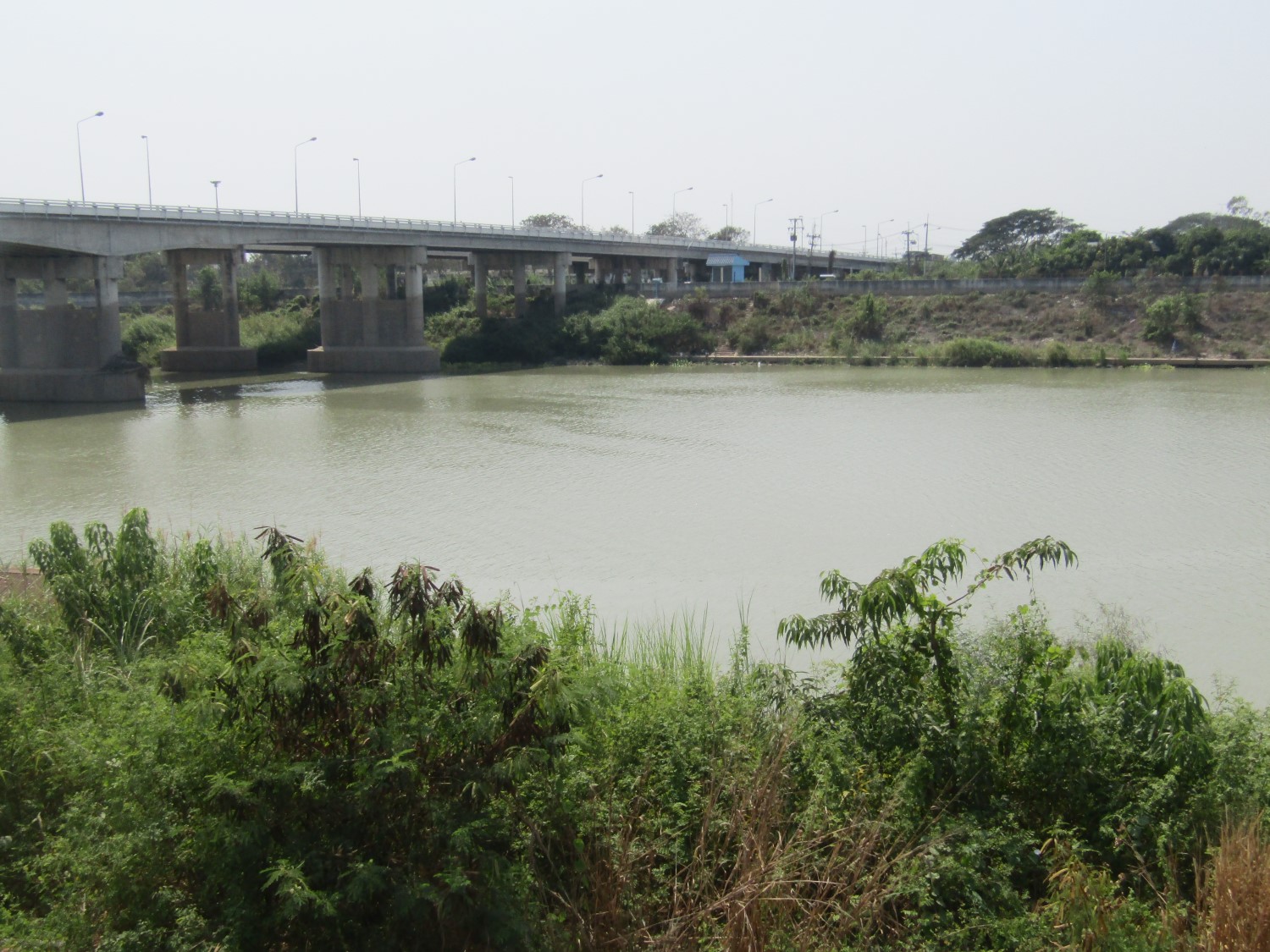
Pa Mok Bridge
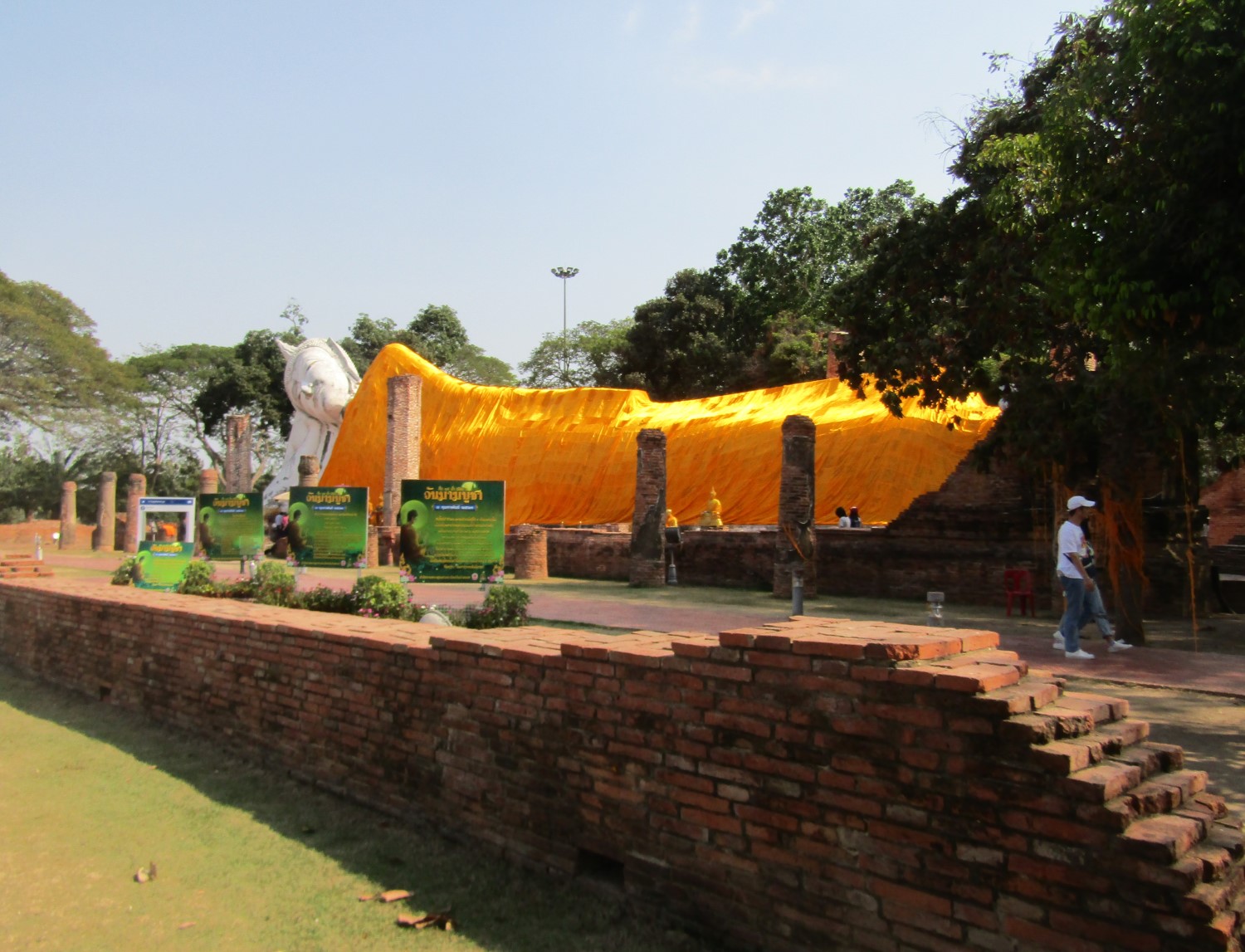
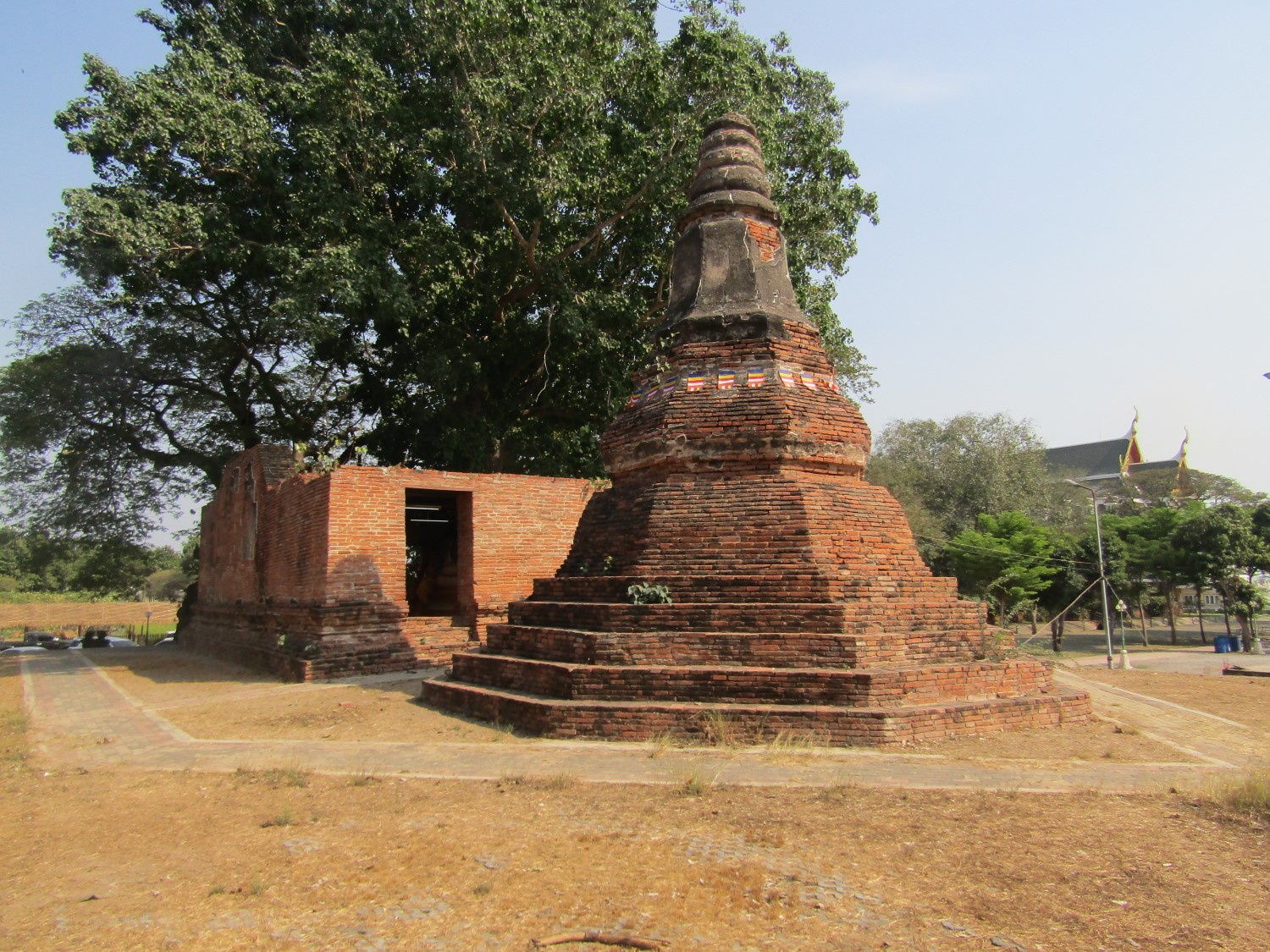
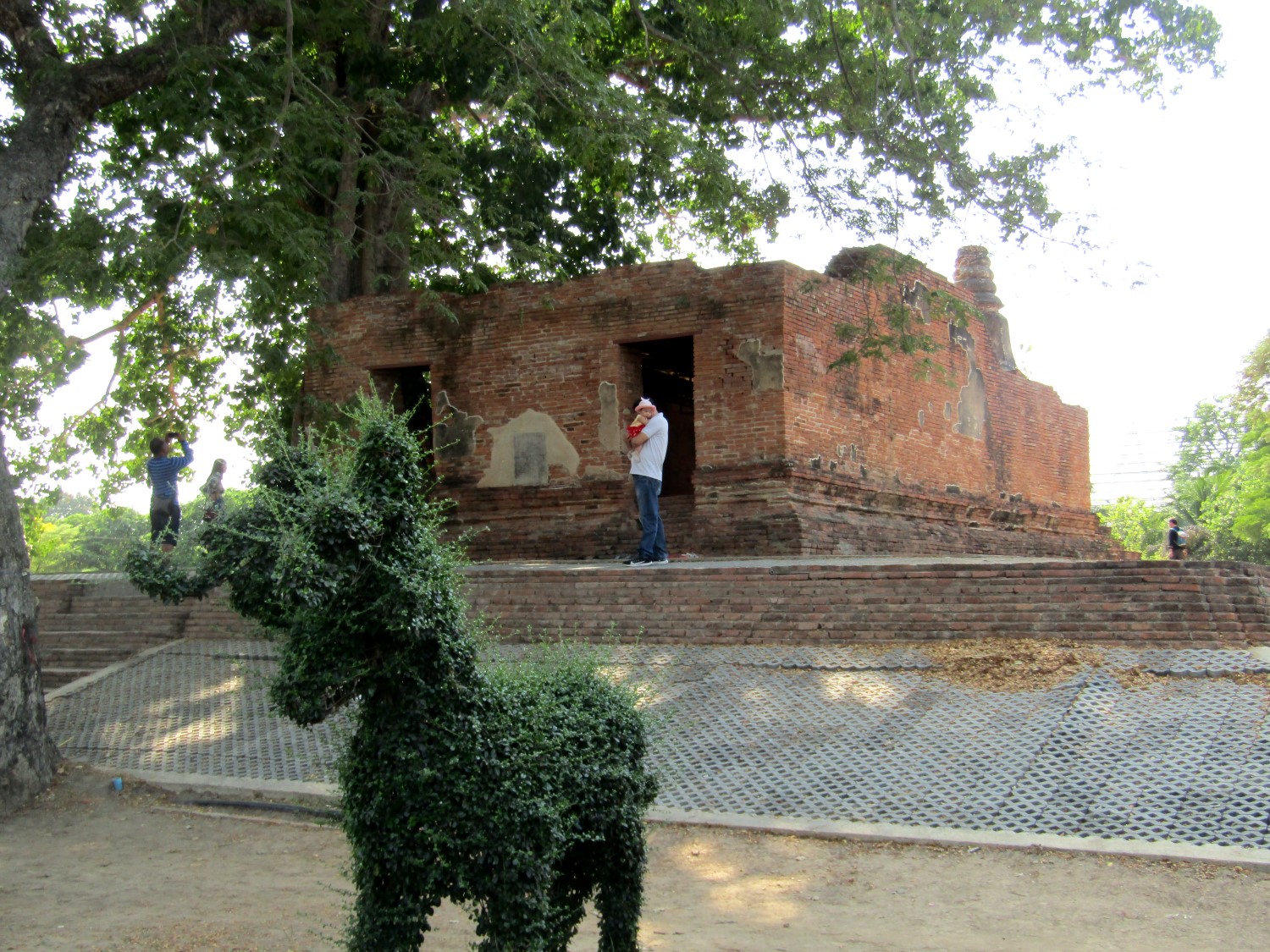
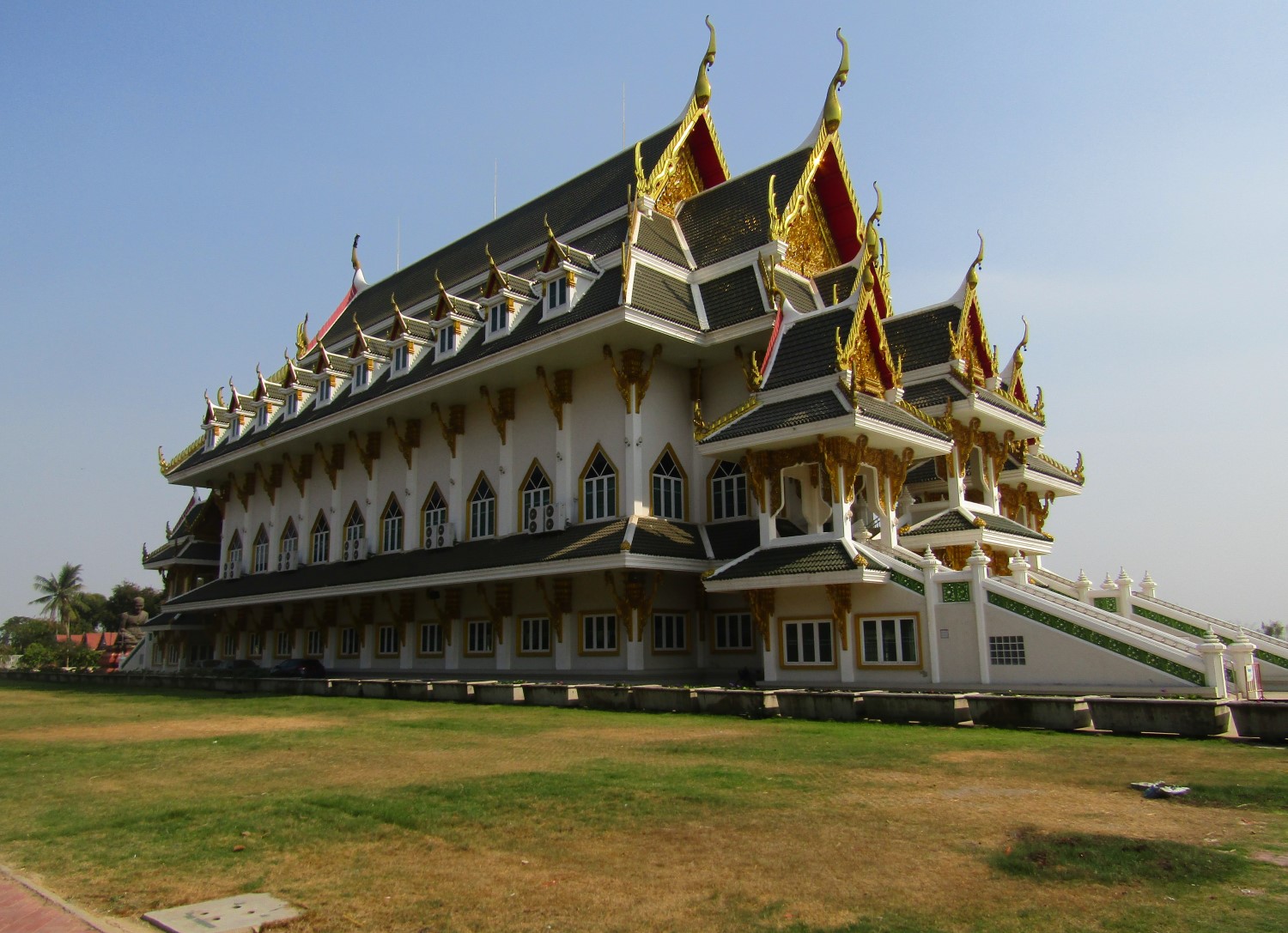
Wat Khun Inthapamun
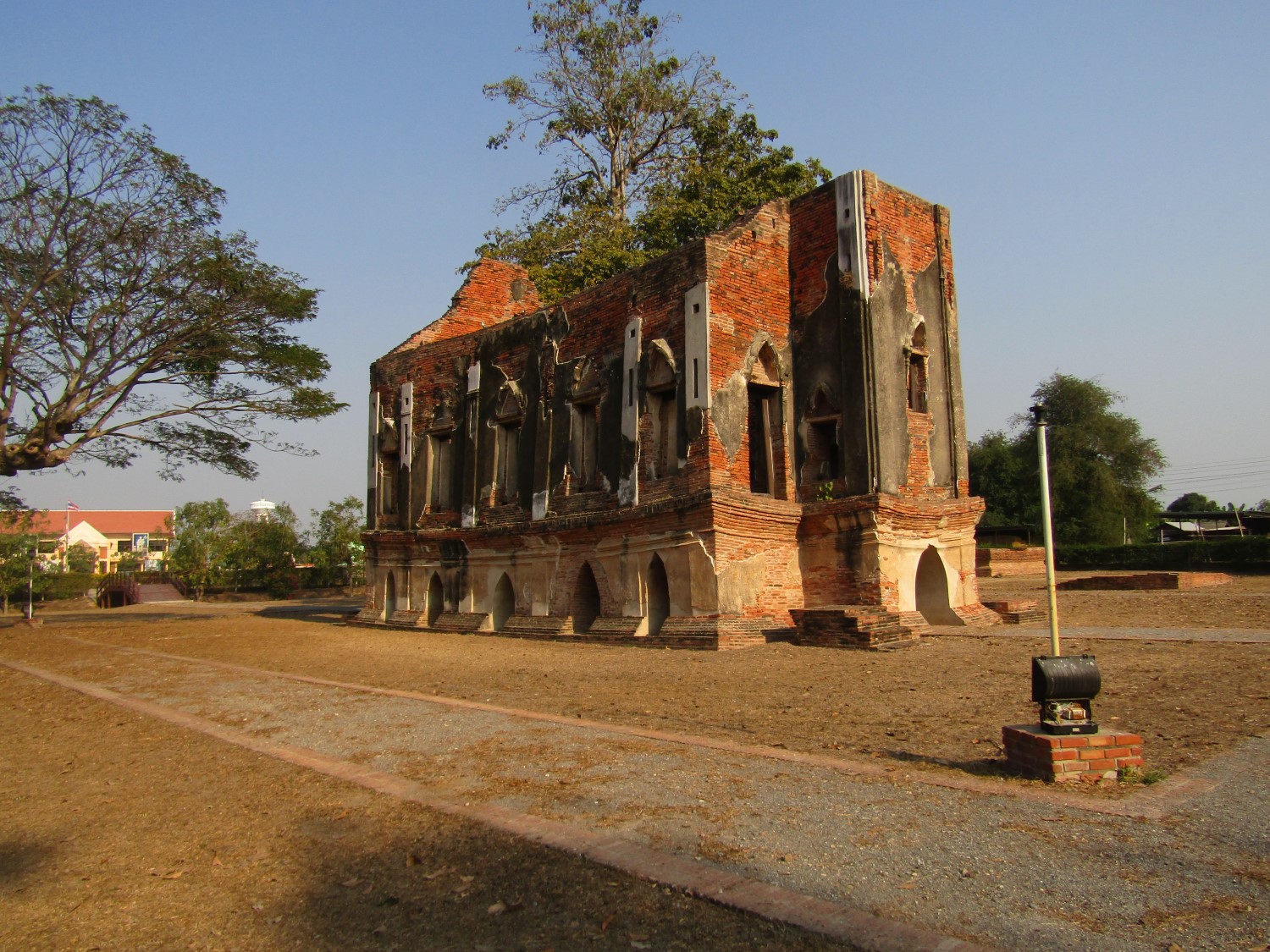
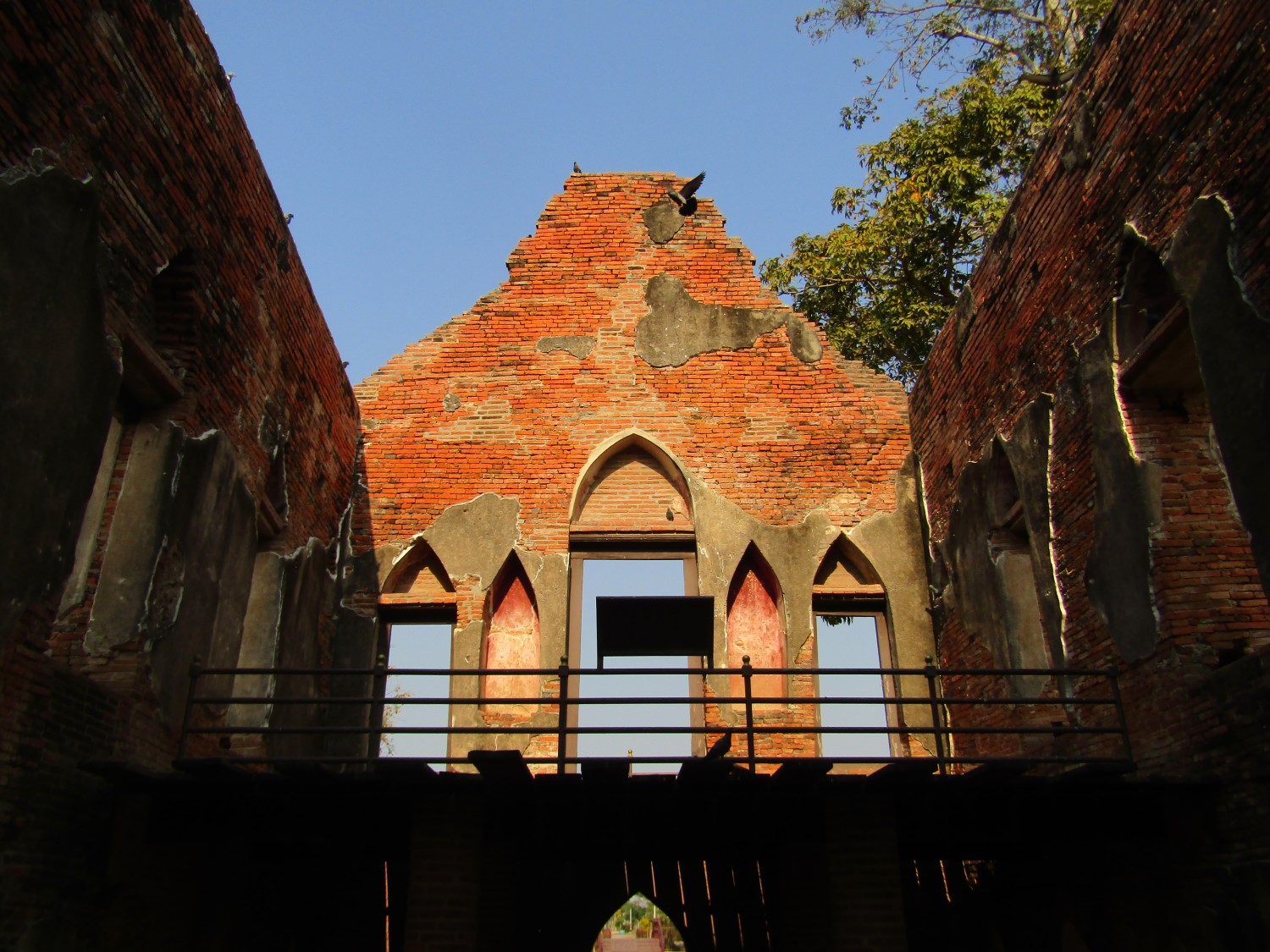
Kham Yat Palace Hall
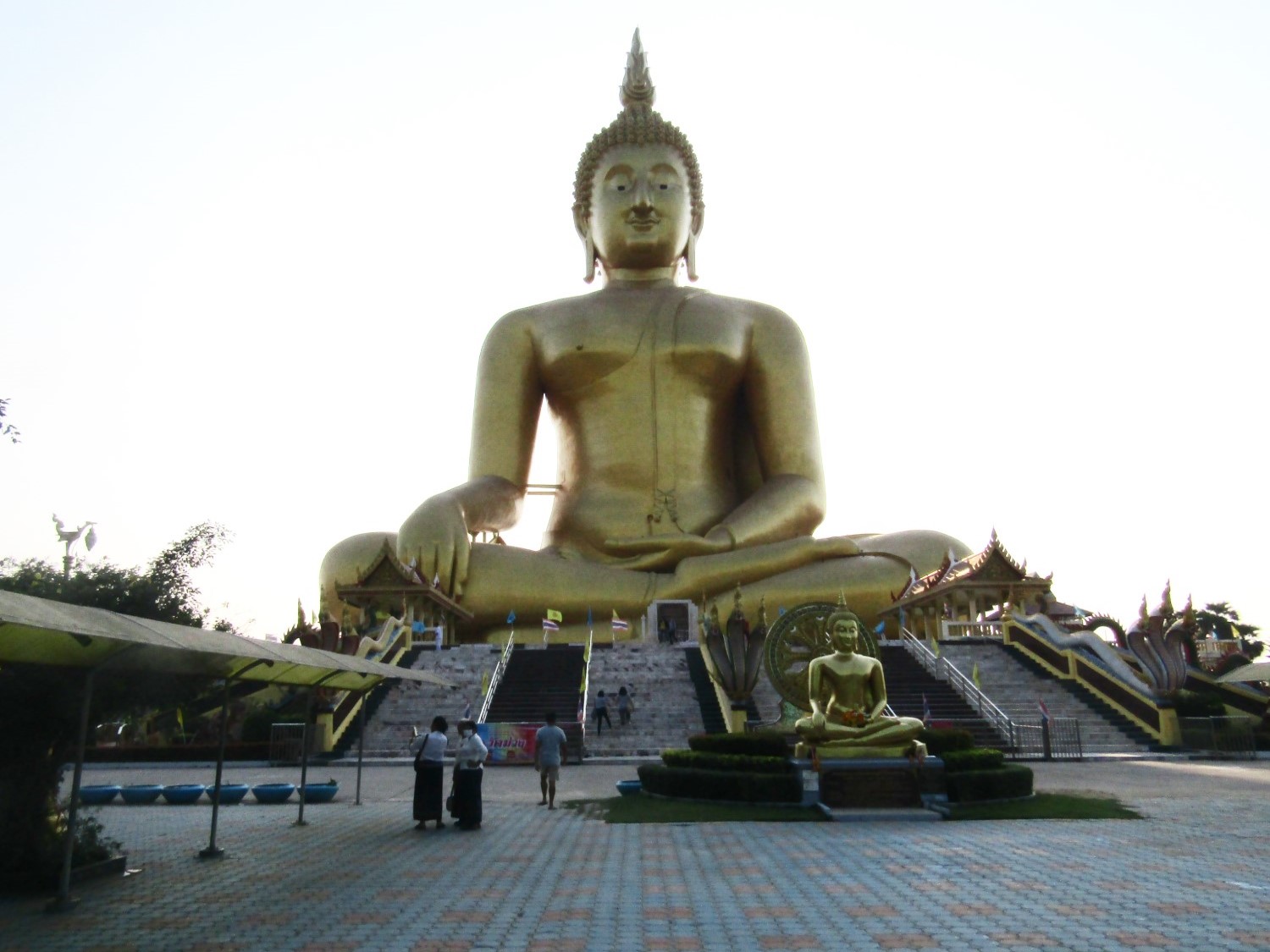
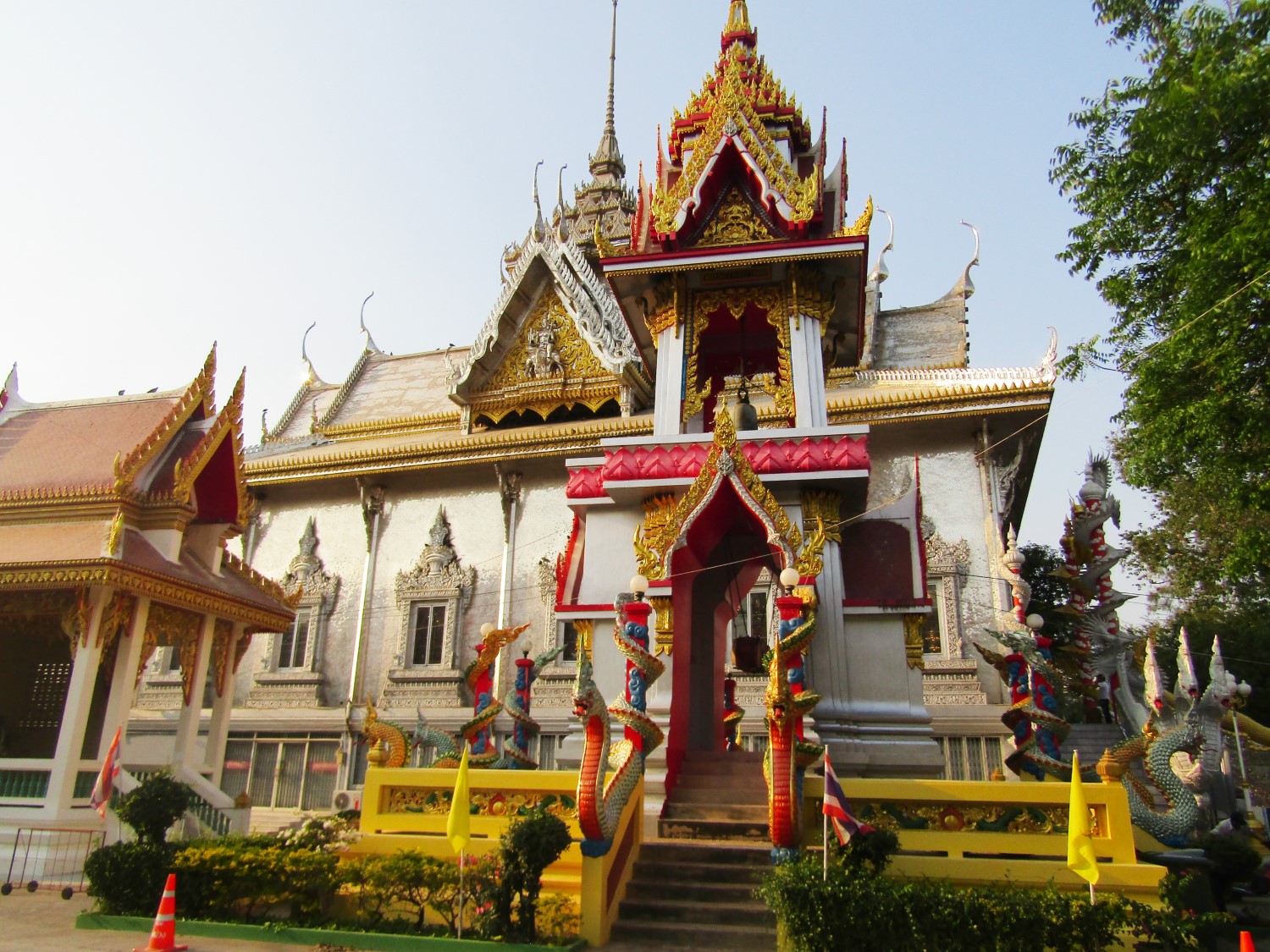
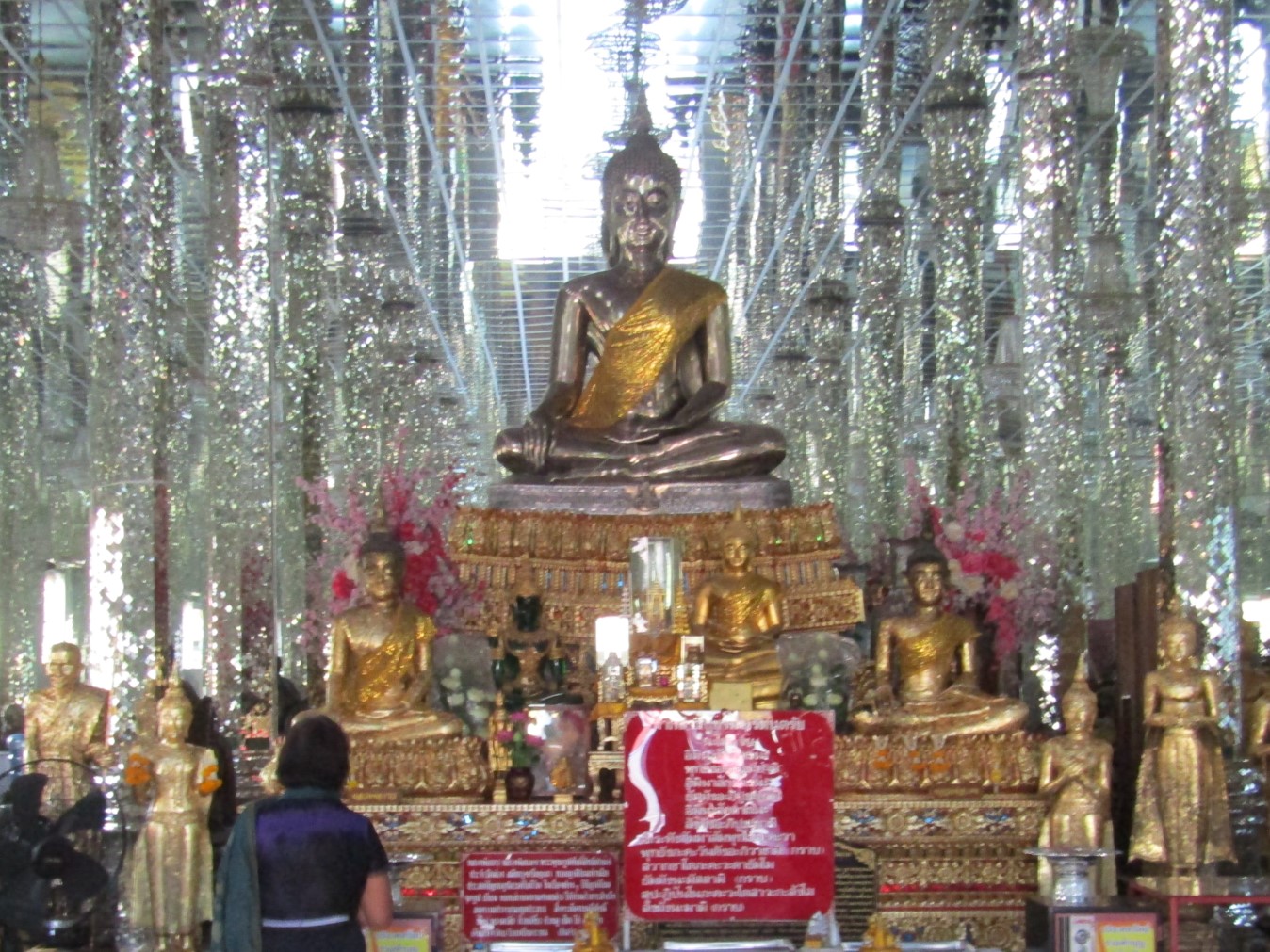
Wat Muang (Purple Temple)
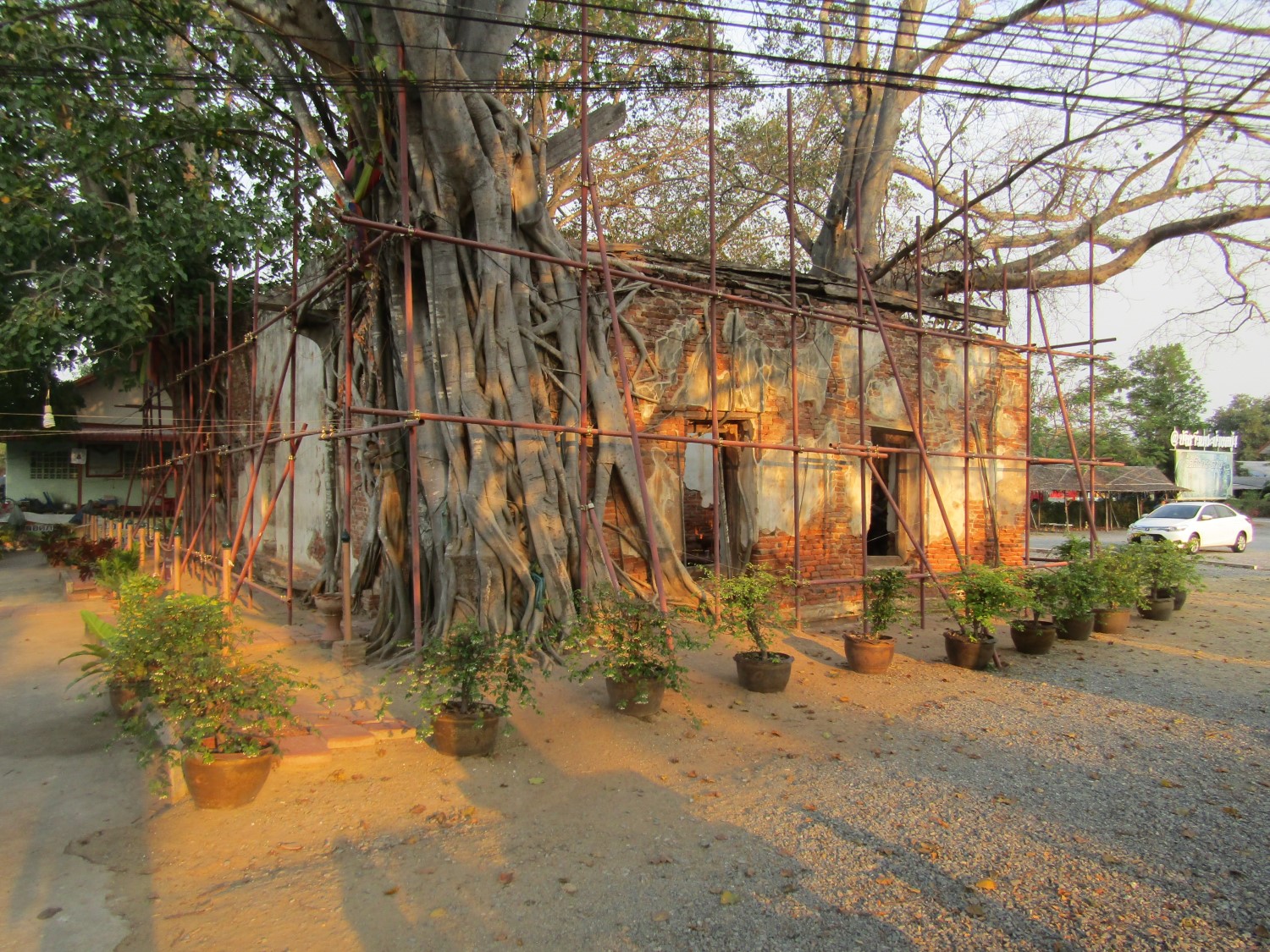
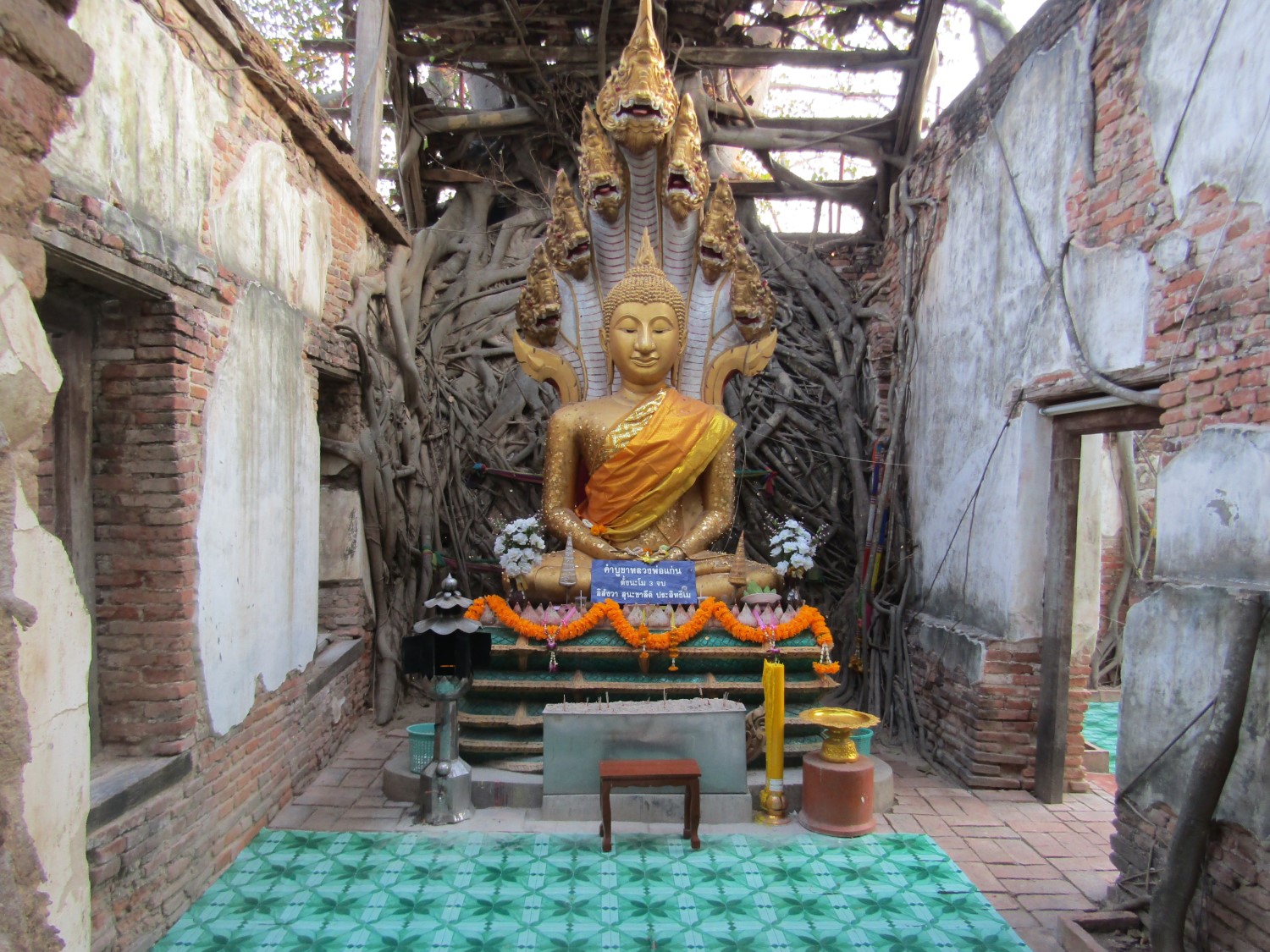
Wat Sang Kratai
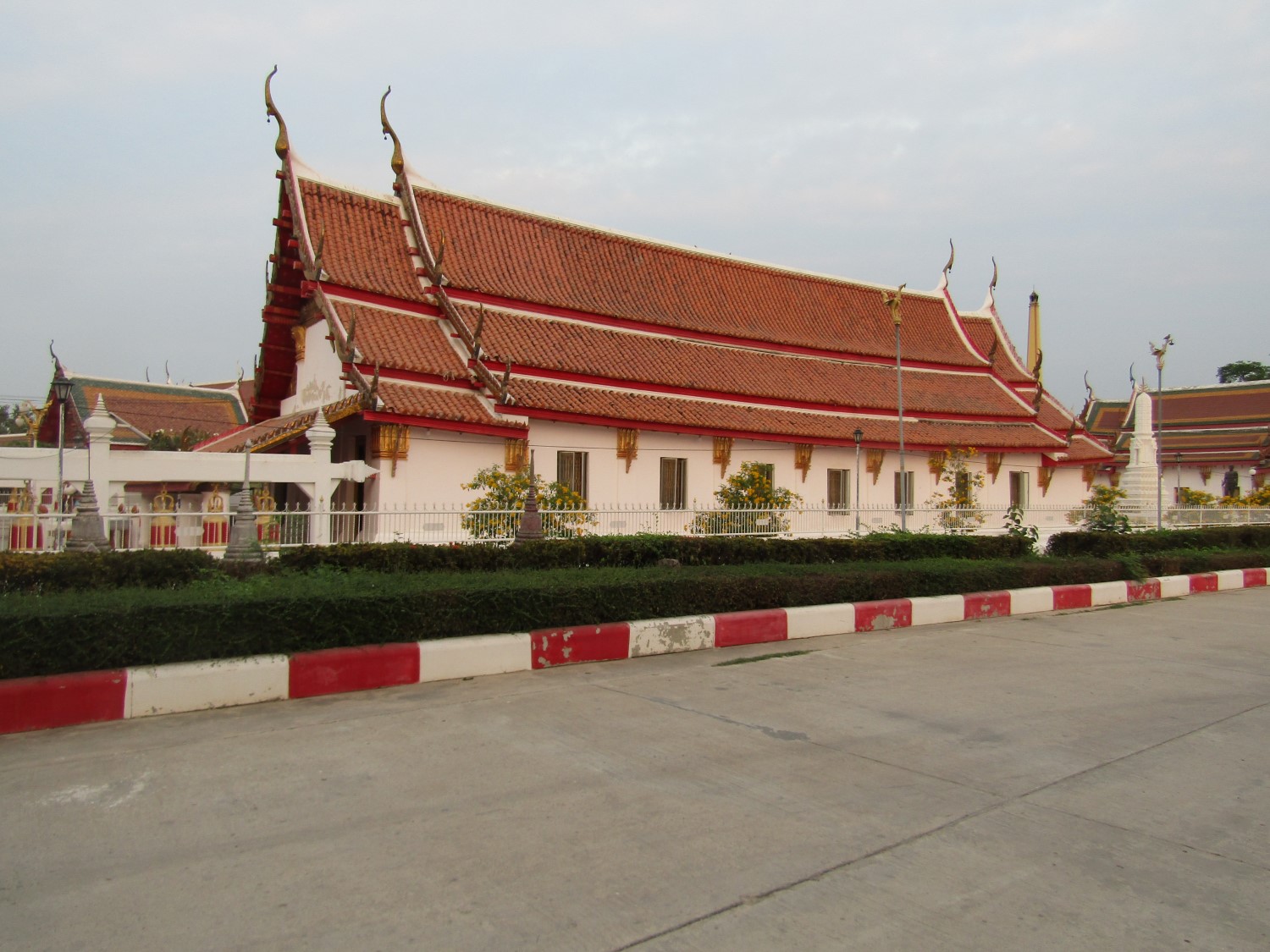
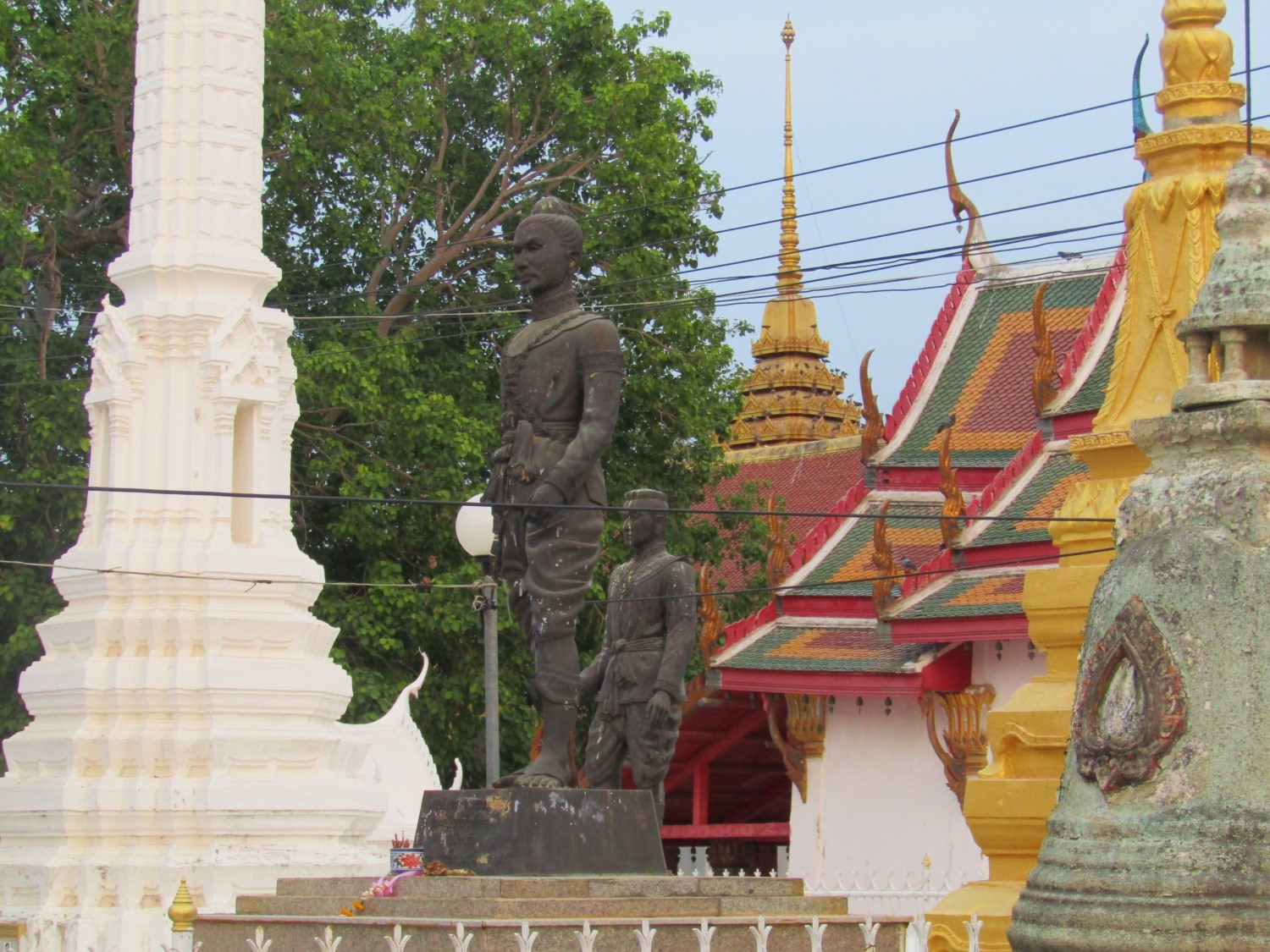
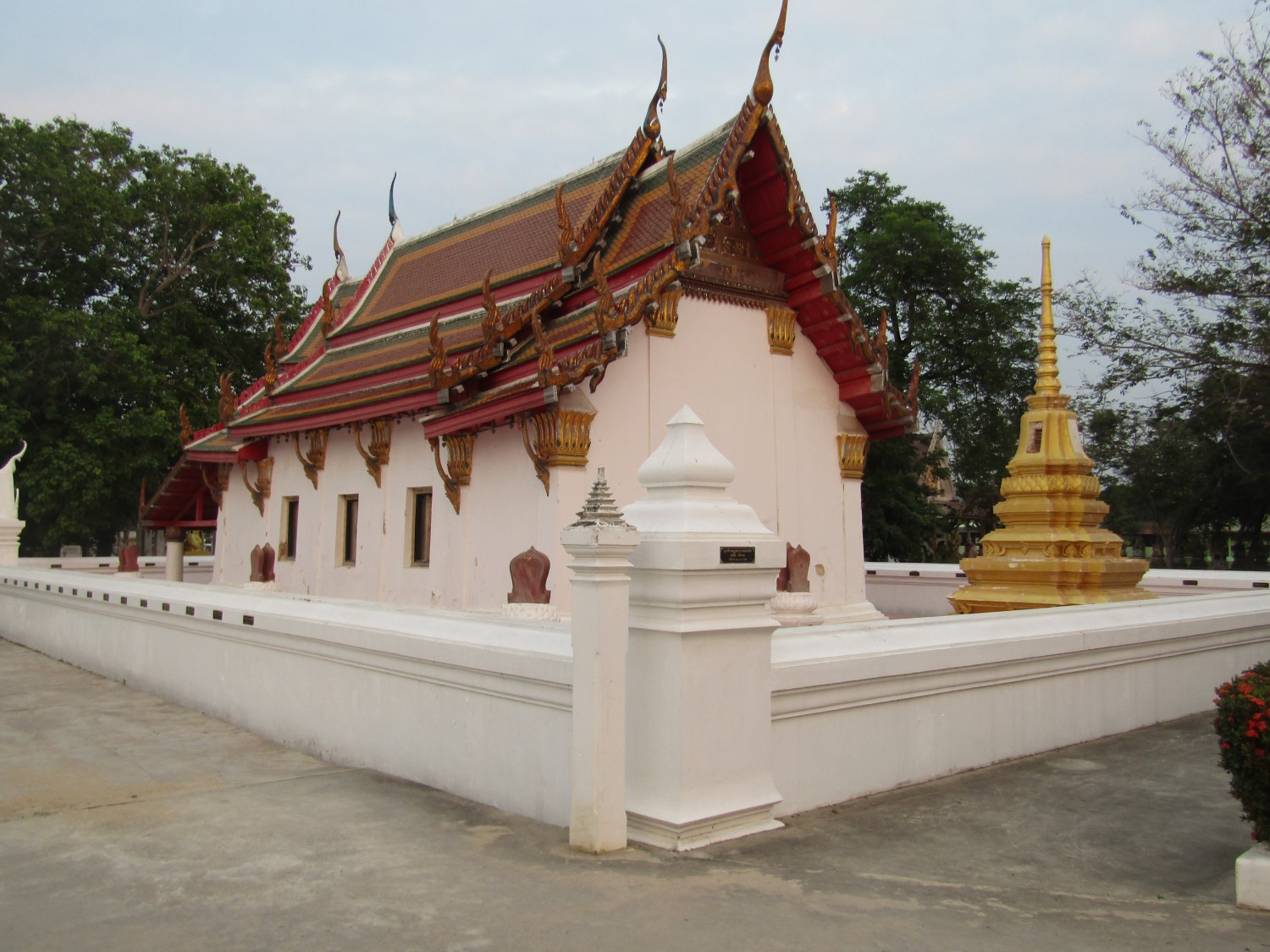
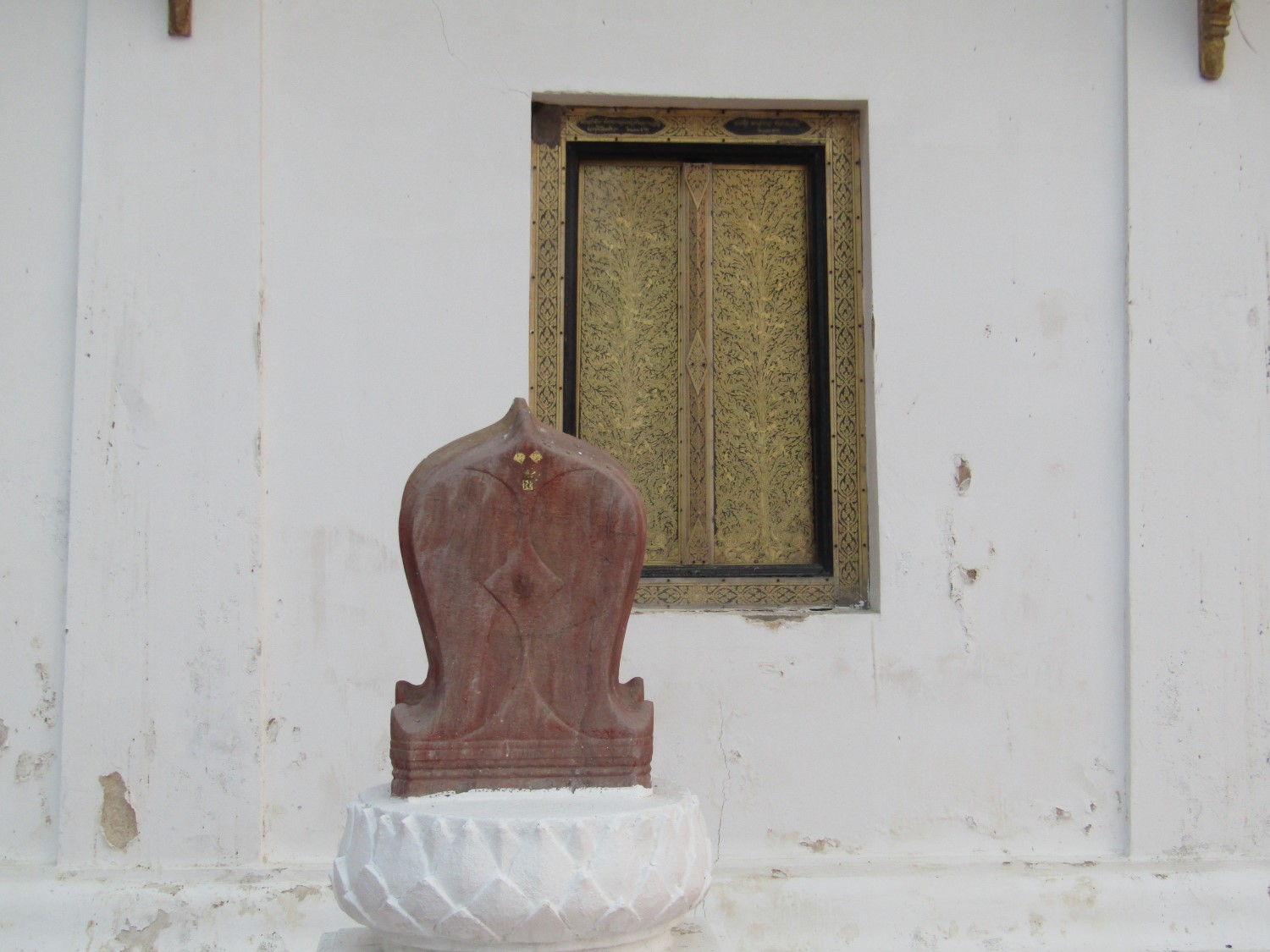
Wat Pa Mok Worawihan
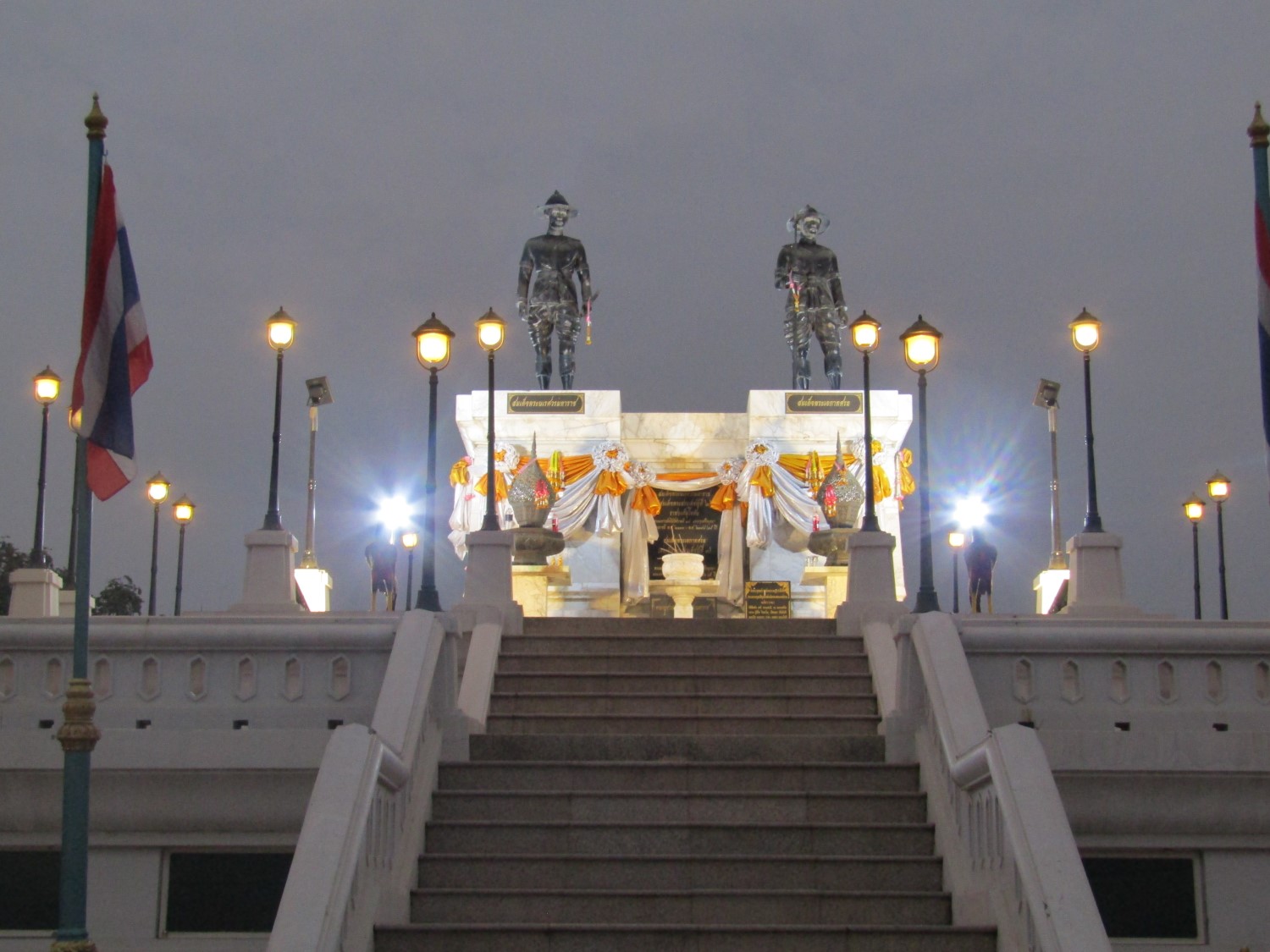
Nai Dok Nai Thongkaeo Monument